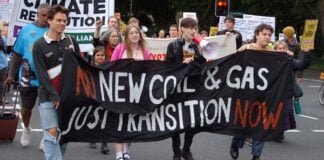Solidarity produced this leaflet for today’s coal seam gas rally in Sydney.
Opposition to coal seam gas (CSG) mining, especially amongst farmers in NSW and Queensland, has turned toxic. The industry is rapidly expanding, with efforts to drill for CSG even in central Sydney.
Much of the anger has focused on the process for extracting the gas, known as “fracking”, which involves pumping toxic chemicals into the ground in order to force out the gas.
But the “gas rush” is also a disaster for climate change.
Mining companies and other advocates of gas argue that it is climate-friendly, as it can generate power with less emissions than in a conventional coal-fired power station. “It’s a cleaner energy source”, according to Climate Change Minister Greg Combet.
When the emissions from power stations alone are considered, gas power plants have about half the emissions of coal. But as Melbourne Energy Institute researcher Patrick Hearps has said, “Taking into consideration the total life cycle emissions of coal seam gas, particularly methane, its emissions intensity is likely to be a lot closer to coal fired power.”
During coal seam gas mining, methane gas leaks out at a much higher level than during conventional gas extraction. Even very small amounts have a serious impact. Methane gas released into the atmosphere is a potent greenhouse gas, 72 times worse than carbon dioxide over a 20 year period.
Belinda Robertson, head of the Petroleum Production and Exploration Association has noted that, “Australia has a lot of CSG: as much as 250 trillion cubic feet, according to the CSIRO, which is enough to power a city of one million people for 5000 years.”
Coal seam gas mining is rapidly expanding across NSW and Queensland, with production increasing by 32 per cent a year between 2003 and 2008.
Expanding the use of gas is also central to the Gillard government’s carbon tax plan. Climate Change Minister Greg Combet told Lateline in March, “For baseload electricity generation it will be gas-fired electricity that we see emerge, and for that… we need a carbon price in the economy.”
This gas rush needs to be opposed. The shift the government has planned from coal power stations to gas would lock in its use for at least 30 years—the life of a new gas plant.
This shows why the carbon tax is not a step forward on climate change. Instead of locking in new emissions from gas power we need to transition straight to renewable energy sources.
Despite $10 billion from carbon tax revenue going to a Clean Energy Finance Corporation, there is no evidence this will increase the use of renewable energy beyond what will be delivered under existing policies like the Mandatory Renewable Energy Target.
Yet it is perfectly possible to power Australia on 100 per cent renewable energy using existing technology.
Denmark already draws 20 per cent of its energy from wind farms alone, Germany 7.5 per cent of its power. Australian wind energy makes up less than 1 per cent of energy use—despite the fact that Beyond Zero Emissions estimates it could produce 40 per cent of our power.
Spain is building 4000MW of solar power plants in the next three years, enough to replace two of NSW’s largest coal power stations, Bayswater and Mt Piper. Storage technology allows them to produce power 24 hours a day.
But it will require government investment to get these technologies off the ground. The NSW Greens calculate a start could be made by funding three small solar thermal power stations for $2 billion each.
This would need to be the start of a large-scale spending program, like the $20 billion the government is spending on its broadband network in the next three years, or the $57 billion spent on stimulus after the 2008 global financial crisis.
We need to build a climate movement powerful enough not just to stop the spread of CSG mining, but to force governments to seriously fund renewable energy.





